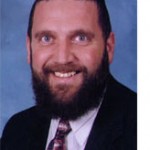By Rabbi Baruch Lederman

SAN DIEGO — Avraham grew up in a world where the norm was idolotry. His father was a card carrying idolator. That was the family business. But Avraham, through his penetrating insight and honest analysis, realized that this norm was wrong. Despite the social mores, despite fierce, even violent resistance he held on to what he knew was right.
In 1883, a creative engineer named John Roebling was inspired by an idea to
build a spectacular bridge connecting New York with the Long Island.
However bridge building experts throughout the world thought that this was
an impossible feat and told Roebling to forget the idea. It just could not
be done. It was not practical. It had never been done before.
Roebling could not ignore the vision he had in his mind of this bridge. He
thought about it all the time and he knew deep in his heart that it could
be done. He just had to share the dream with someone else. After much
discussion and persuasion he managed to convince his son Washington, an up
and coming engineer, that the bridge in fact could be built.
Working together for the first time, the father and son developed concepts
of how it could be accomplished and how the obstacles could be overcome.
With great excitement and inspiration, and the headiness of a wild
challenge before them, they hired their crew and began to build their dream
bridge.
The project started well, but when it was only a few months underway a
tragic accident on the site took the life of John Roebling. Washington was
injured and left with a certain amount of brain damage, which resulted in
him not being able to walk or talk or even move.
“We told them so.”
“Crazy men and their crazy dreams.”
“It`s foolish to chase wild visions.”
Everyone had a negative comment to make and felt that the project should be
scrapped since the Roeblings were the only ones who knew how the bridge
could be built. In spite of his handicap Washington was never discouraged
and still had a burning desire to complete the bridge and his mind was
still as sharp as ever.
He tried to inspire and pass on his enthusiasm to some of his friends, but
they were too daunted by the task. As he lay on his bed in his hospital
room, with the sunlight streaming through the windows, a gentle breeze blew
the flimsy white curtains apart and he was able to see the sky and the tops
of the trees outside for just a moment.
It seemed that there was a message for him not to give up. Suddenly an idea
hit him. All he could do was move one finger and he decided to make the
best use of it. By moving this, he slowly developed a code of communication
with his wife.
He touched his wife’s arm with that finger, indicating to her that he wanted
her to call the engineers again. Then he used the same method of tapping her
arm to tell the engineers what to do. It seemed foolish but the project was
under way again.
For 13 years Washington tapped out his instructions with his finger on his
wife’s arm, until the bridge was finally completed. Today the spectacular
Brooklyn Bridge stands in all its glory as a tribute to the triumph of one
man’s indomitable spirit and his determination not to be defeated by
circumstances. It is also a tribute to the engineers and their team work,
and to their faith in a man who was considered mad by half the world. It
stands too as a tangible monument to the love and devotion of his wife who
for 13 long years patiently decoded the messages of her husband and told
the engineers what to do.
Avraham knew in his gut that he was right. Avraham and Sarah were willing to stand tall in the saddle against all odds, against the “current wisdom”, against all detractors. They could have chosen the convenient path of least resistance. Instead they went on to forge a new light – Judaism. They went on to be the founders of our people and our faith.
Dedicated by Barbara Malady Woolf in profound gratitude to Hashem, for His great guidance in her life when she needs it the most.
*
Rabbi Lederman is spiritual leader of Congregation Kehillas Torah in San Diego